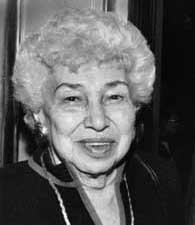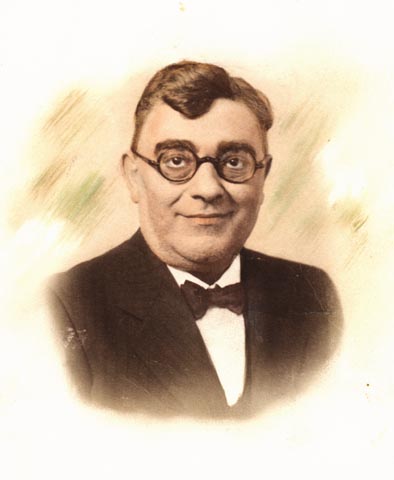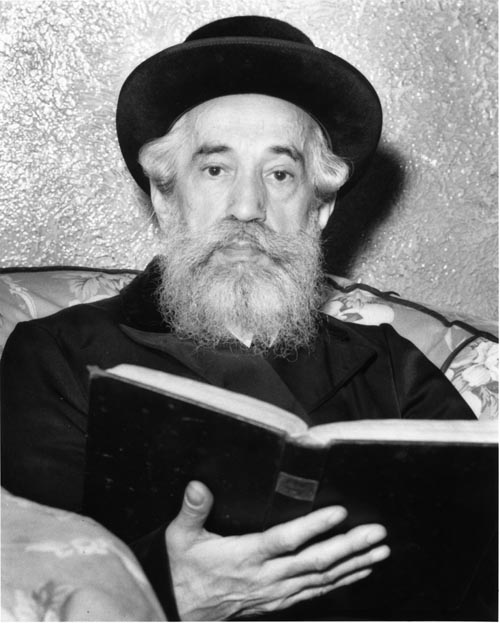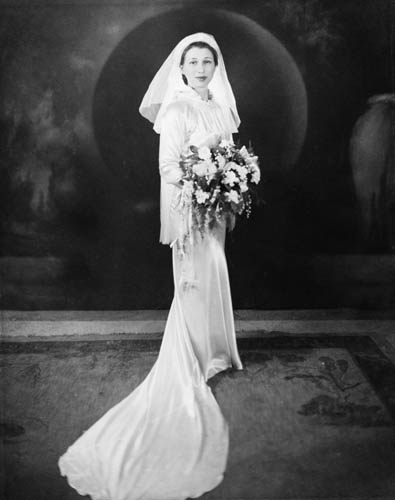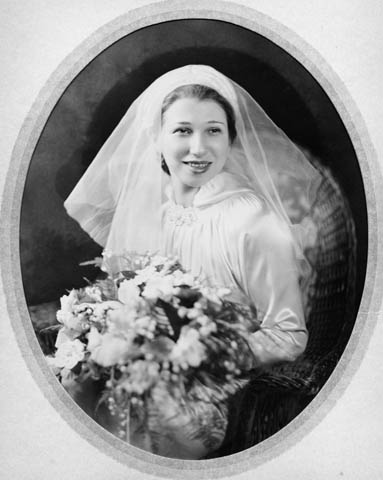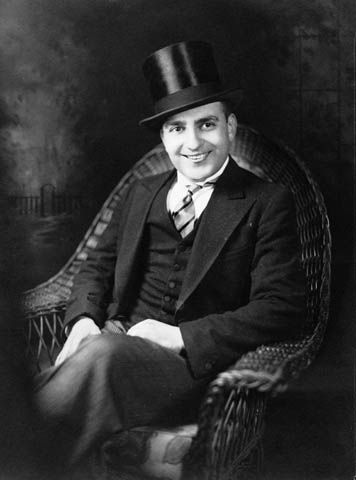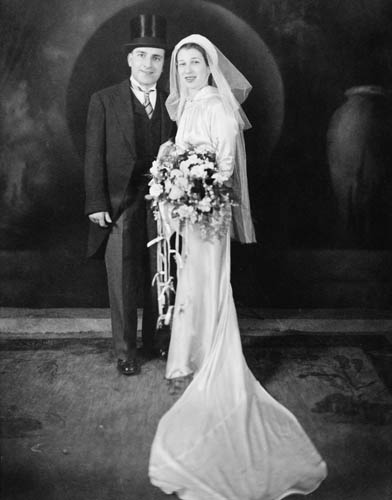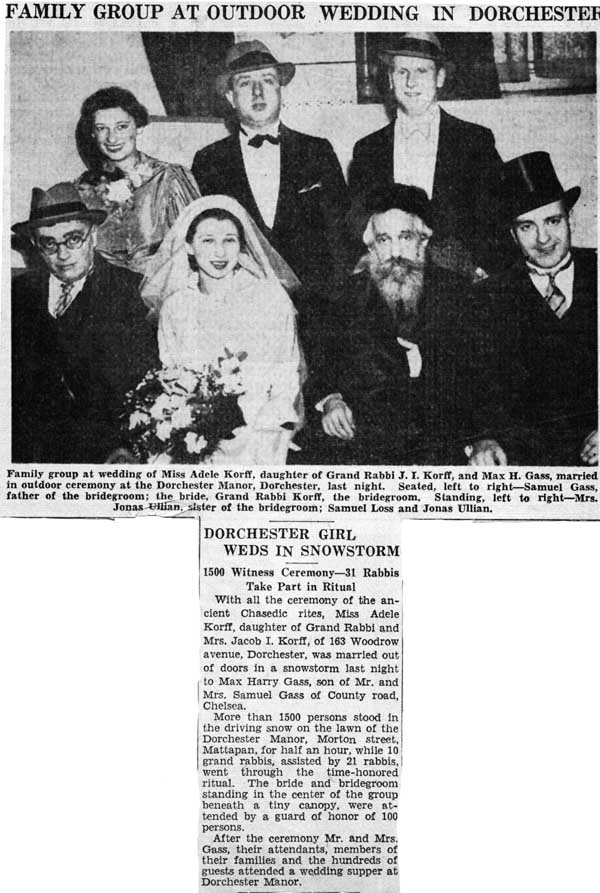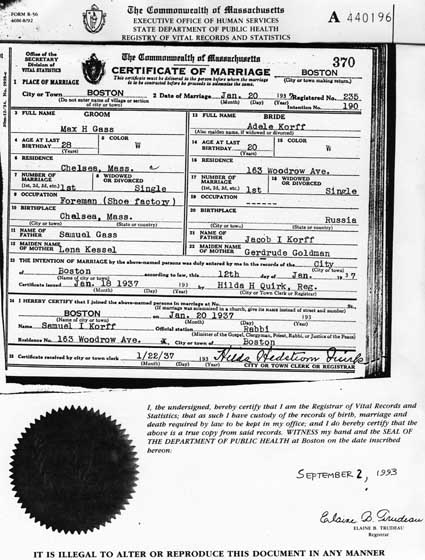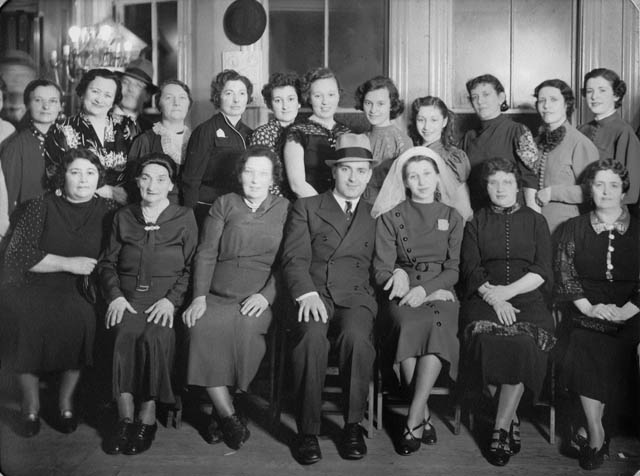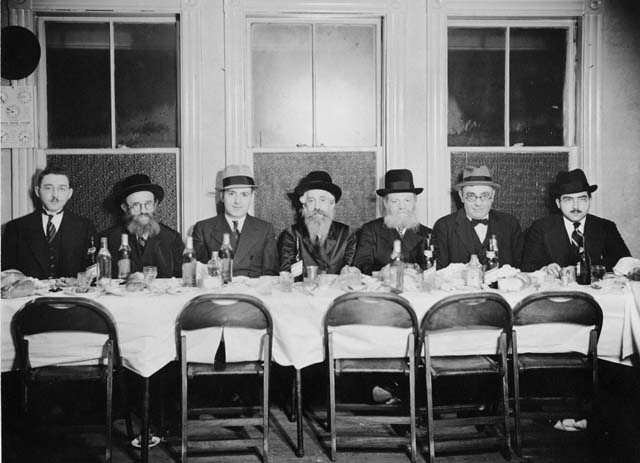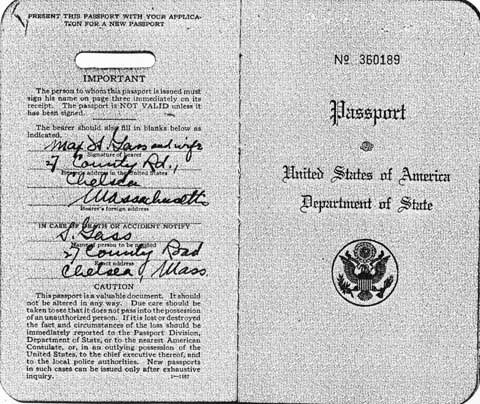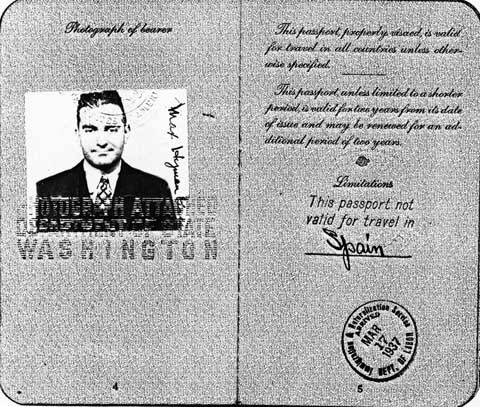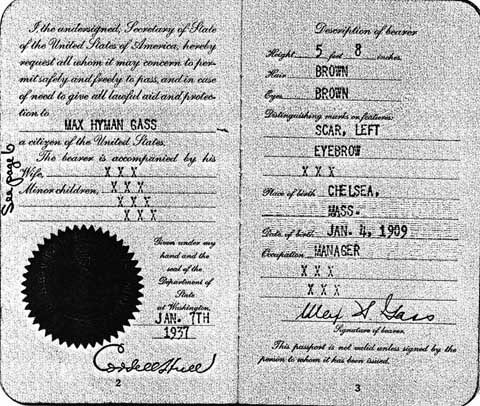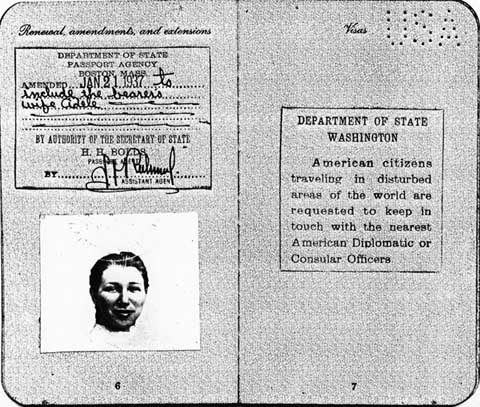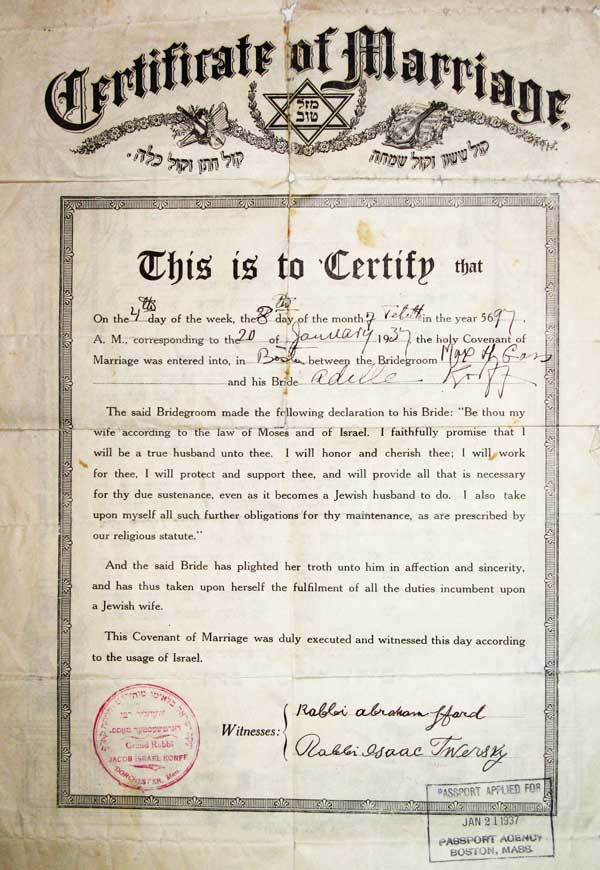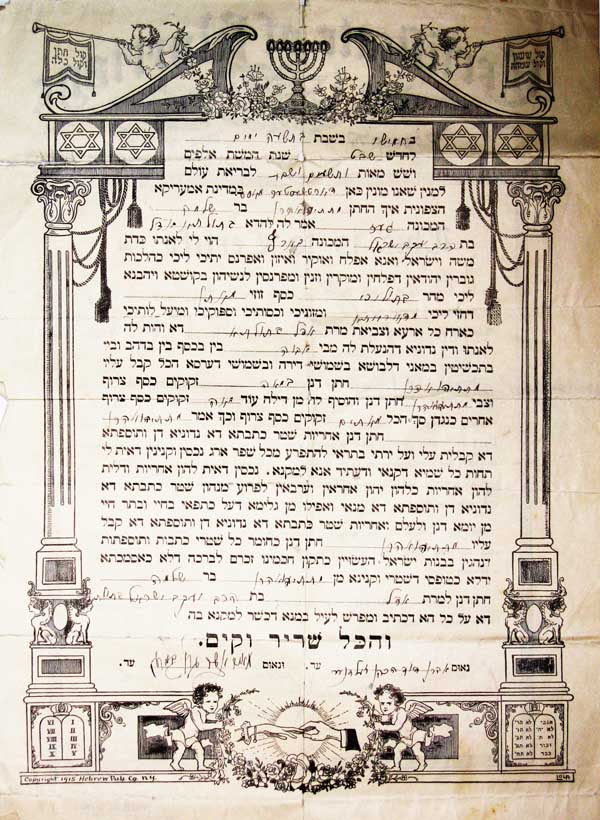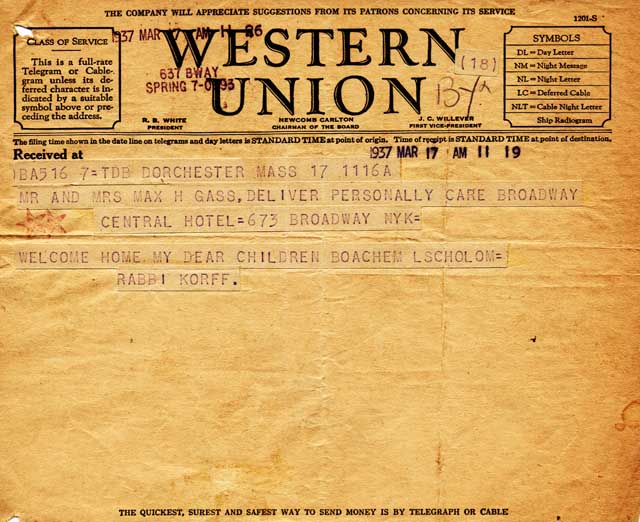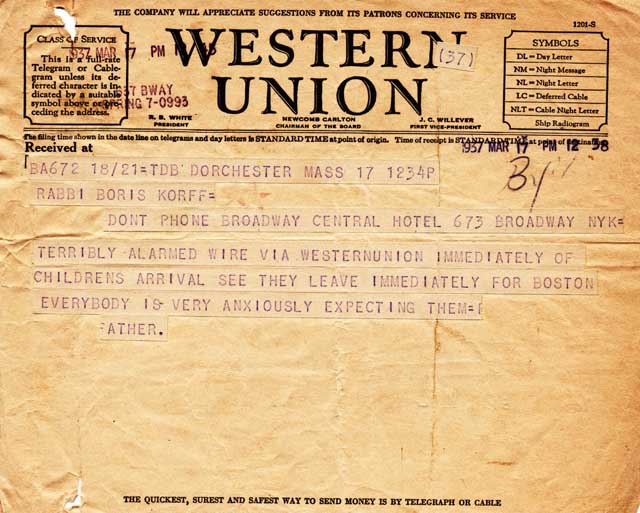Growing Up in America, Courtship and Marriage
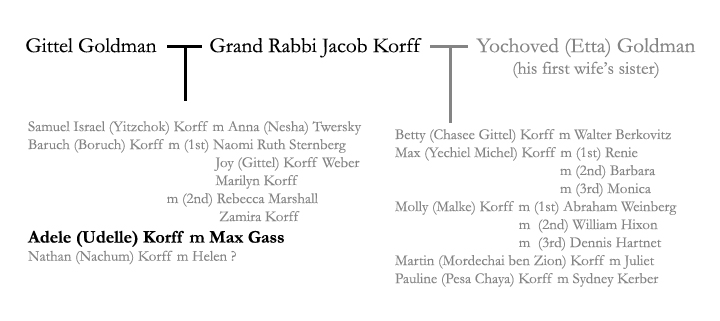
ADELE KORFF GASS WAS BORN in 1918 in Novograd-Volynsk, Russia (called Zvil by its Jewish population), the third of four children, and the only girl, born to Grand Rabbi Jacob Korff and Gittel Goldman. In 1919, when the youngest child, Nahum was still an infant, Gittel fell victim to a marauding Ukrainian in a pogrom. The children were now without a mother and their father was without a wife. A year after his wife’s murder, Rabbi Korff married his sister-in-law, Yochoved (Etta) Goldman. In 1922, Etta gave birth to a daughter, Betty, the first of five children from that marriage. Max was born two years later in Poland. In 1927, Rabbi Korff moved his family to the United States, settling in Dorchester, Massachusetts, and within three years Molly, Martin, and Pauline were born.
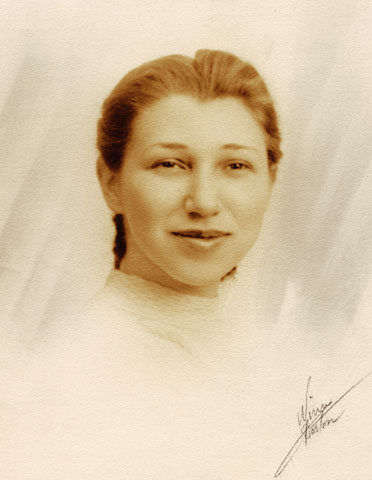
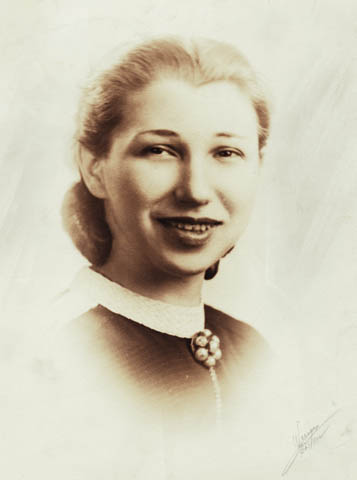
These undated photographs of Adele show her before she married Max. They were apparently taken the same day. Note that her collar in both pictures is the same.
As the daughter of a renowned rabbi, Adele’s life was not her own. In a series of interviews in the early 1990s Adele shared her recollections:
“When I was child I was treated differently. If I went to a movie and it wasn’t just so, a self-appointed committee of women would complain to my father that I went to a movie that wasn’t befitting a rabbi’s daughter. Once a year, we had the Zvil Ball and I always attended this dance. I was very popular, and a committee of women whose daughters weren’t as popular would go to my father afterward and complain that I had behaved not like a rabbi’s daughter. I had a friend who babysat, and what was wrong with her? She was a nemkama (a maid) and the committee complained that she was not a befitting companion for a rabbi’s daughter. Finally, my father said to the meddlers, Adele may not have a mother but she still has a father.
Listen to Adele Korff Gass describe life as a rabbi’s daughter:
“When I was about eleven or twelve I would sometimes go home with Mrs. Kaplan [the Korff’s live-in housekeeper] on weekends. Her husband lived in the West End. He abused her but not when I was there. She ended up in the hospital because he stabbed her. After she recuperated, she came back to us. Eventually Mrs. Kaplan left us permanently and we had a whole string of other housekeepers. They had difficultly getting along with my stepmother and so they never lasted long. When they left, I was stuck with the cooking.
“Mrs. Kaplan gave me my first introduction to womanhood. When I awoke on my 13th birthday I felt unwell and noticed I was bleeding. Terrified, I screamed for Mrs. Kaplan. She raced into my room, immediately assessed the situation, and slapped my face. Now you are woman, she said.”
Adele was ready for dating earlier than her father would have allowed but her friend, Mrs. Kaplan, gave her an alibi. According to Adele:
“My father never knew about my dating antics. Mrs. Kaplan, who liked me very much, covered for me. I used to sneak out at night through the synagogue window. My father would come into our rooms to check on us and Mrs. Kaplan would tell him I was asleep and not to disturb me. Meanwhile, I went to the homes of my girl friends and doubled dated with them. We’d go to the movies but not in Dorchester or Mattapan, not any place where anybody knew me. At the end of the date, I’d climb back into the house through the same window and then I’d tiptoe up the back staircase. This was radical behavior for the daughter of a grand rabbi–virtually unheard of. When my sister Molly was old enough, she sneaked out, too, but my sister Betty didn’t.
“I was very popular. I wasn’t that beautiful, but boys stuck to me like glue. I’d get rid of one boyfriend, and I’d get another one, and every one would propose marriage.”
Part of Adele’s popularity may have been due to the fact that she looked and acted older than she actually was. She recalled:
“I lied about my age. I always made myself two years older and I went out with men much older than myself. I was found out when my cousin threw me a sweet 16 party and all the Yeshiva boys who used to take me out realized how young I was. They stopped dating me. I had one persistent suitor, Rabbi Lipschitz. He followed me to Florida when I was taking care of my father who was ill. He followed me to New York. He promised me the moon.”
Adele broke the mold in other ways as well:.
“I was a rebel. My father didn’t believe in educating girls or allowing girls to work. He believed the role of the woman was to be a good mother and wife. I went to public school but I owned only two dresses. Each day I put one on and washed out the other. When I was 14 or 15, I took a job at Kolpuski’s bakery. Early in the morning I would sneak out and show up for work at the bakery at six. I worked for a couple of years and nobody in my family found out. My father would have killed me. I gave the money to my brothers or I bought groceries. I didn’t spend it on myself.”
Another way she rebelled was to marry a non-rabbi. It was a tradition among Hasidim to marry within the family–usually cousins–but Grand Rabbi Jacob Korff’s daughter, Adele, had no intention of marrying a rabbi. She explained:
“As a rabbi’s daughter I had to be on my toes constantly. I told my father I would never marry a rabbi because being a rabbi’s wife was just too restrictive. A rabbi’s wife belongs to the public and I didn’t feel that anybody had the right to judge me.”
And then fate lent a hand and Adele met Max Gass:
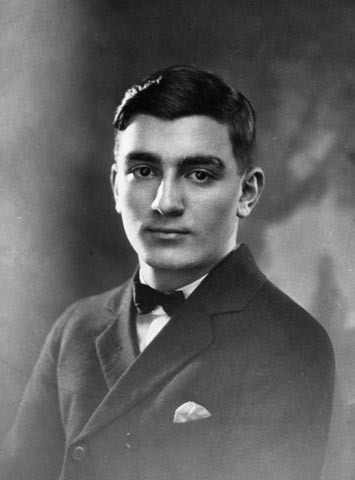
Max Gass
“One day when I was 16 and all dressed to go out, a Hebrew teacher named Mr. Dubrow came to our house. He was friend of our family and friend of the Gass family. Later that day at the Gass home in Chelsea, Dubrow said to Max Gass, I saw a girl who used to be just a kid, and now she’s a beauty. Max asked for my phone number and called me for a date. He told me a friend of mine had given him my phone number.
“You couldn’t have gotten the number from any of my friends, I told him, because they all know I don’t go out on blind dates.
“I turned him down, but he replied, I was told you were a good sport, but I guess I was told wrong.
“I hated to be called a bad sport. So I said, I tell you what. We’ll both arrange dates for later in the evening. That way if I don’t like you I can leave, and if you don’t like me you can leave. It was the only way I would consent to meeting him. So we made a date.
“Max came over that evening with a big bag of peanuts. He came in, plunked himself down, and sat there eating the peanuts. He said, I like what I see. And he wouldn’t let me go out on the other date.
“We went to the symphony and while we were sitting at a little table, he said to me, What color are your eyes?
“Brown, I answered.
“Will you marry me? he asked. He proposed on our first date.
“After that, he came over every day. If I went out with another man, when I returned Max would be sitting on the porch or waiting in his car for me. Each day he drove a different car. He used his sister’s car, his brother-in-law’s car, the factory car… I said to my father that Max must either be a crook, or he works in a garage and he’s using the cars. After a few weeks of this, I told Max I didn’t think I wanted to get married.
“A couple weeks passed and we didn’t see each other. Then he called to tell me his grandfather [Kessel] had died. He said he felt low and couldn’t I see him?
“When Max came to pick me up, he always entered the dining room and said hello to my father first. He would pick up one of the many books my father had out on the table and read from it, to impress him and show off his knowledge of Judaism. This happened over and over.
“After my father had his first attack, he went to Sunset Lodge, in Sharon, Massachusetts, to get some peace and quiet. We always had visitors at our Woodrow Avenue home and my father felt compelled to greet everyone who came in the door and give them his time. Whenever my father needed rest he went to Sunset Lodge for a couple of weeks. It was located next to a lake. My stepmother stayed at home.
“Max drove me out to Sharon to visit my father. It was Max’s idea, not mine. My father always had books out, even on vacation, and Max would read from these books and have a discussion with my father. I am not sure if this was to impress my father or to reassure him that his daughter was going into good hands even though she wasn’t marrying a rabbi. He needed my father’s blessing.
“My father realized I wouldn’t marry a rabbi and he approved of my match with Max. The Gass family was religious, and Max was very well educated in English and Jewish studies. My father felt Max would look after me, and take care of me financially.
Samuel Gass
“In addition, my father liked and respected Max’s father, Samuel Gass, because Sam was a brilliant, brilliant man. He was self-educated, and gifted in business. He studied Jewish scriptures by himself and observed the Jewish laws to the letter. Sam laid tefillin every day, kept the Sabbath, and to a certain point he made his children observe the Sabbath.”
Besides the fact that she was in love, Adele also appreciated that her marriage to Max would free her from the restrictions she had known as a member of a rabbi’s family. She remembered one example of this:
“During my engagement to Max, Max would sit on the steps, while I was out and my brothers would tease him about my hair. In Jewish tradition, married women shave their hair to make them unattractive to other men. My brothers said they would cut off mine before I got married. Max loved my hair—it was way down to my waist because my father believed that girls should never cut their hair. I wore it wrapped around my head and Max loved to take the pins out. If I had married a rabbi, I would have had to cut it off.”
Although Adele believed her marriage was the result of kismet, her brothers tell another story, one of two fathers planning a marriage between their children, as was customary in Orthodox Jewish culture in those days. Adele’s brother, Baruch Korff, remembered how their match came to be:
“Max didn’t win Adele, and Adele didn’t even know. It was decided between the two fathers. People, particularly among the immigrants, had begun to call Shlomo [Samuel Gass] Reb Shloime, that’s an honorary title. And his son was getting on in years, the only son. He sought a marriage contract, a mate for his son of high rabbinic background. So Shlomo hired a matchmaker, and he says, I heard that the Zviller Rebbe has a daughter seventeen years old and a beauty.
“The matchmaker said, You’ll not get that babe. I’m not going. I’m going to the Tuska rabbi. That’s another rabbi who had a daughter. This whole story, the matchmaker told my father in the presence of my brother and myself. The matchmaker came to my father and told him exactly what he told Shlomo, that he’s aiming too high.
“Nu, nu, nu, we’ll talk about it‘ my father says.
Grand Rabbi Korff
“He will give a lot of tzedakah (donations to charity), you just name where. He will also provide the children with the proper income, said the matchmaker.
“So, my father says to him, Tell him we’ll see.
“Then my father says to my older brother and to me, Go talk to Adele.
“She laughed at us. What was Mattes, twenty-seven, twenty-eight at the time? And she was sixteen. She said to me, Get out of here. And so we duly reported to father.
“A week later the matchmaker bought Shlomo to my father. And they both wanted something, so it was ready made. They didn’t have to go to London for fitting.
“Next, my father wanted to meet Shlomo’s wife and all the children. They all came, and the reason why he wanted this was for Adele’s sake, so that Adele would meet the others. Anna [one of Max’s sisters] was very good to Adele, very good. Anna was a lovely young lady.
“Shlomo says to my father, Mattes keeps asking, when is he going to meet her.
“Then came The Day. Father was very smart. He arranged with Auntie [Etta] to get all the children out of there. They’d be looking and giggling and all that. And Max does not come to see Adele; he comes to see the Rebbe. She just happens to be there. We had some friends on Calendar Street, so my older brother arranged it that they would go there for a visit.”
As things turned out the fathers gave their blessings and Adele and Max got engaged. What their fathers didn’t know was that Adele continued to see other men until the day she married. According to Adele:
“We got engaged but I continued to date other men until the day I married. I would get out of his car and go into Max’s car. My father didn’t know about my behavior. There was a 20-year-old man that I liked very much. I had met this man at the Zviller Ball and he had been very good to me the time my father had a heart attack in Florida. Usually, I traveled with my father and took care of him–my stepmother never went. This time my father went alone. When he took ill, my friend paid for my airfare so I could join my father. He wanted to marry me. When Max and I married he sent a telegram to wish us luck and express the hope that the marriage wouldn’t last long. Max was furious. Years later, after my husband died, this man started calling me again. He had been widowed for three years and wanted to start a new relationship with me but he never got anywhere.”
The Marriage of the Century
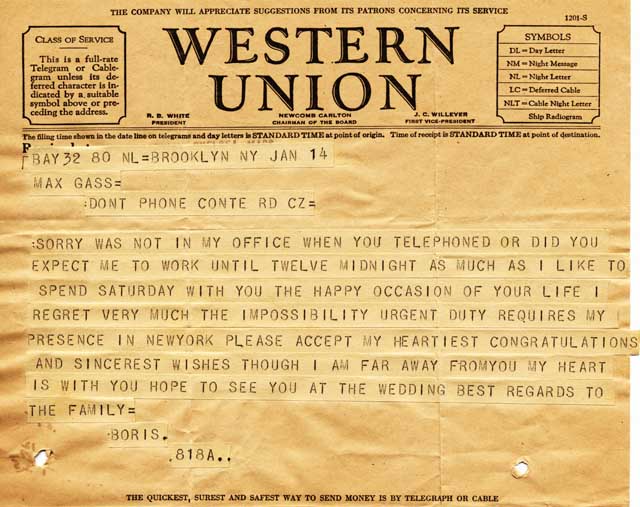
Telegram sent by Adele’s older brother Boris (Rabbi Baruch Korff ) to Max six days before the wedding
After courting for six months Adele decided that she and Max belonged together and they were married. In a spectacular ceremony that stopped traffic –literally.
“Max and I married on January 20, 1937, I was attending public high school but I married four months before I would have graduated. I had wanted a June wedding but Max was afraid I would change my mind. I had a reputation for breaking engagements so Max bribed me with a honeymoon trip to visit my mother’s grave in Russia. My father encouraged this because he felt that at 16 I would be an old maid!
“My father wanted a small wedding because he was not in the position to pay for a large one. But my father-in-law, Samuel Gass, wanted a wedding befitting the marriage of his son to the daughter of a grand rabbi, so he paid for it. Five thousand people came to the ceremony. I was the first grand rabbi’s daughter to marry outside the family and there had never been another wedding like mine.
Bride and groom: Adele Korff and Max Gass
“People came from Israel, from England, from all over the world. They came out of respect for my mother, who had given her life to save them, and for my father their rebbe. The whole town of Dorchester stopped for that day. My wedding was front-page news. Roosevelt was inaugurated the same day and they gave me more publicity than they gave him. It was pages full. I was married by thirty-six rabbis and the wedding lasted seven days.
“All the guests gave tzedakah in honor of our wedding. They gave chai ($18) or double chai ($36). The money went to thechevra kiddusha (burial society), the matzoh kitchen, to Jews in Russia, and to other organizations.
“Despite a guest list of 5000, I was not permitted to invite my friends to the wedding. However, I did have a dinner dance for all of my friends a couple of weeks before it. Max was permitted to invite two of his childhood friends to the ceremony. Our fathers invited whomever they wanted.
“Before the ceremony we followed the custom of veiling the bride. In a ritual called the badeken (the covering), Max lowered the bridal veil over my face. It took place in a room indoors. A rabbi accompanied by a fiddler sang Hasidic tunes as I was led outside to the ceremony.
“The wedding took place in Dorchester Plaza outside the Dorchester Morton Hebrew School. My sister Betty Berkowitz was fourteen that year and she remembers, the hordes of people. She had to push through the crowds to see me get married.
“Max and I married under a chupah (canopy) beneath the stars. Marrying beneath the nighttime sky symbolized the hope that our offspring would be as numerous as the stars. The chupah consisted of an embroidered cloth mounted on four wooden poles. Four disciples of my father held it up. The only light came from candles and from the stars.
“There had been a terrific ice storm so I had to cover my beautiful wedding gown and cape with an overcoat, and I wore galoshes so I could stand in the snow. People paid to watch the ceremony from a neighboring building. I think they were charged 75 cents. Morton Street was blocked off and there were police everywhere keeping order. Dozens of newspaper reporters covered the ceremony.
Typical coverage of the wedding story
See the extensive coverage of Max and Adele’s wedding in Yiddish and English-language newspapers
“Max was dressed in a white cotton kittel (robe), as a symbol of purity. Escorted by his father, my father, and the rabbis, he walked down the aisle first and stood under the canopy. Then I came, accompanied by my stepmother, Auntie Etta, and Max’s mother, Lena. Etta and Lena carried lit candles and I led them in a procession around the chupah, circling the groom 13 times. Then I joined Max under the chupah–standing on his right side.
“I have a very long ketuba (marriage contract) handwritten in Hebrew by a soifer` (scribe). It guaranteed that Max would support and take care of me and that I wouldn’t be in want. It also guaranteed that I would be a good wife and provide Max with children. During the wedding ceremony after the wine was blessed and Max gave me a ring, the ketuba was read out loud in Hebrew. Nobody except the rabbis and the yeshive bokhers(Yeshiva students) understood it. Near the conclusion of the ceremony the Sheva Berachot (Seven Blessings) were recited. These blessings place the bride and groom within the context of Jewish history, beginning with creation of the world and the Garden of Eden when life was perfect, and ending with the prophecy of the end of days when life will be perfect again. The honor of bestowing the blessings was divided among the many rabbis attending so each could play a role in the nuptials. The entire ceremony from beginning to end was a very long and drawn out affair. Max and I were famished–following custom we had both fasted all day.
Max and Adele’s marriage certificate
“At the end of the wedding ceremony, Max broke a glass. I always thought this custom was sexual in nature, to symbolize the breaking of the hymen, but it also has a more spiritual meaning. The broken glass serves as a reminder of the destruction of the Temple in Jerusalem. In moments of great personal joy we must not forget the harsh realities of life.
“After the ceremony, the fiddler began to play again. Max and I were led to a small room to spend 15 minutes alone together. This custom, called yichud (togetherness), dates back to antiquity when the bride and groom consummated their marriage in a tent immediately after the ceremony. In modern times, the yichud is used to break the fast of the bride and groom and to give the newlyweds a breather. We were provided with a small snack. Our wedding pictures were photographed in a bathroom because there was no room any place else.
Adele and Max with some of their female family members. Seated left to right: Minnie Gass Naimark, Rachel Razin Kessel, Lena Kessel Gass, Max Gass, Adele Korff Gass, Etta Korff, ? Twersky; Standing: Sara Kessel Michaels, Sonya Gass, Becky Kassel, Sara Gass, Minnie Gass, Anna Gass, Patty Gass, Betty Korff, Nesha Korff, Miriam Twirsky, ?
“The simcha (celebration) consisted of a meal–the seudat mitzvah–and dancing. It was held in the Morton Street Hall, an enormous ballroom. My father’s klezmer band provided the music. Since men and women are not permitted to touch, the men danced together in separate groups, in circles. The rabbis took turns dancing with me. They never held my hand–they grasped onto one end of a handkerchief and I held onto the other. Max and I danced this way, too.
“In Jewish tradition, the bride and groom are considered to be married the first night. The couple is put in a room alone together to consummate the marriage. Because there is bleeding, the woman is then considered unclean so she and her husband must remain separate for seven days. But Max and I didn’t want to stay with anybody, so each night we went to Sharon, Massachusetts, which at that time was a summer resort.”
“Every morning we returned to my father’s house in Dorchester for prayers and a breakfast. There were long tables and chairs set up in my father’s shul. The men and women sat separately. Max sat up front with the rabbis. I stayed with the other women. Each day there was a catered lunch and dinner, too. At the end of the morning and evening meals the Seven Blessings were recited again and special guests were honored by being asked to give one of the blessings. The rabbis summoned me and I sat across the table from my husband until the blessings were over. At night speeches, storytelling, and singing came after the blessings. There was music and drinking, and following Jewish custom, the men danced together but not with the women. This went on for seven days.”
Rabbi Baruch Korff, Grand Rabbi Twersky, Max Gass, Grand Rabbi Jacob Korff, Grand Rabbi (?) from New York, Samuel Gass, and Rabbi Samuel I. Korff
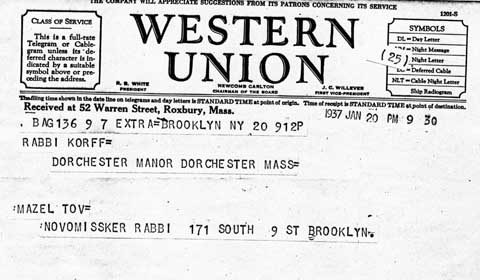
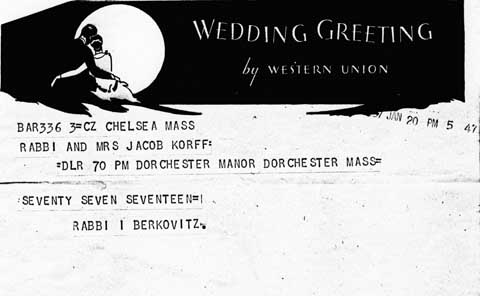
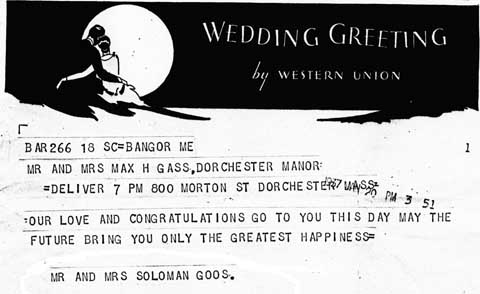
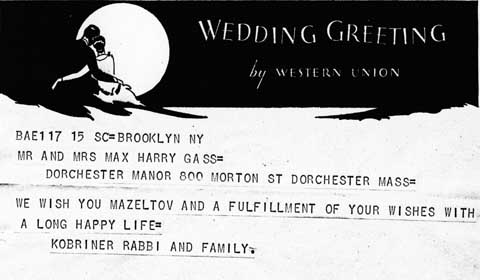
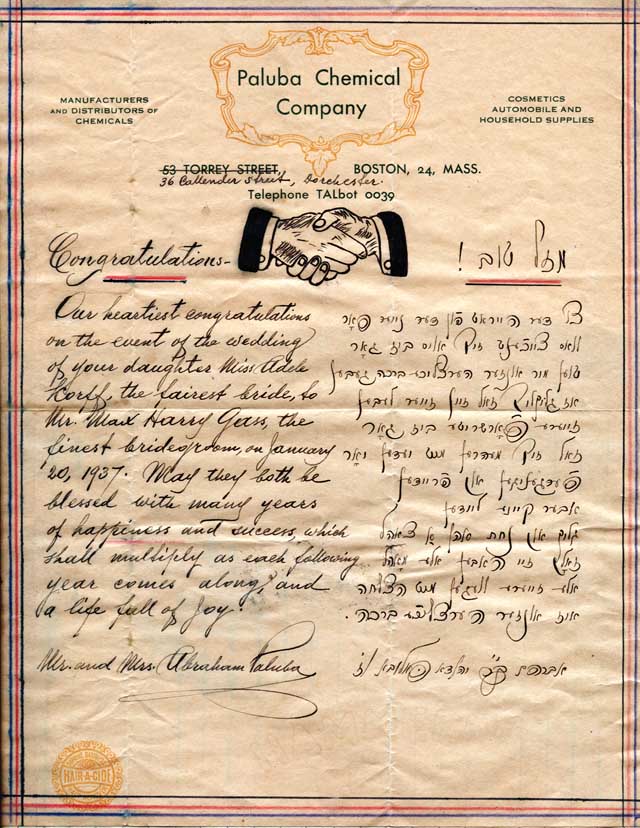
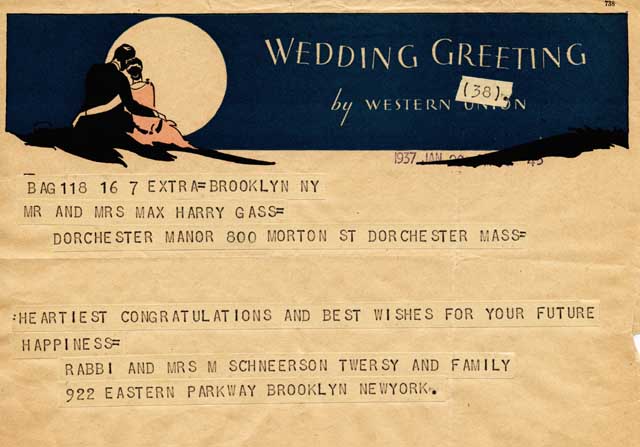
A sampling of the congratulatory telegrams and letters that Max, Adele, and their fathers received from well-wishers
A Russion Honeymoon
For their honeymoon, Max and Adele sailed on the S.S. Aquitania, to Paris, and then took a train to Poland. Adele reminisced about the trip:
“I had last seen Poland when I was nine; I had memories of it. When we got off the train in Warsaw I told the people just where to take me—the place where I had stayed as a little girl, 27 Schmula-mila. We visited friends that I had stayed with when I was a kid. Then Max and I spent a few days in Turiysk, the town where his family had come from. From there we traveled to Germany, where the Nazis were already in power and preparing for war, and then we continued on to Russia.
Adele did not receive her own passport. Identifying information about Adele was added to Max’s passport.
“Max had carried our ketuba with him when he traveled. This was a tradition that he continued until much later in our marriage when the document became frayed and started to fall apart. I finally convinced him to leave it in the safety deposit box. He used to say marrying me was a blessing. He resented anybody taking my time.
The back and front of the ketuba
“While we on the train traveling through Germany, a uniformed Nazi checked our passport and tried to make out with me. I told him I was Jewish and his Fuhrer didn’t like Jews. He replied, My leader doesn’t like Jews but I have nothing against them.Max had a fit.
“We had a problem with the Russian authorities. They confiscated our camera. When we complained to the U.S. Consulate our camera was returned but the film had been removed and the camera had been damaged.
“In Moscow we were given separate hotel rooms on different floors, even though we shared one passport. Max and I kept telling the people in charge that we were married. We even showed them our ketuba. Finally we were permitted to stay together.
“In Russia, we also visited Pinsk, Kiev, Leningrad, and Zvil. When I was in Kiev I gave some people money to maintain my mother’s grave. Amazingly, when I returned in 1981, I discovered that the grave had been kept up, so I left more money for them to take care of it.”
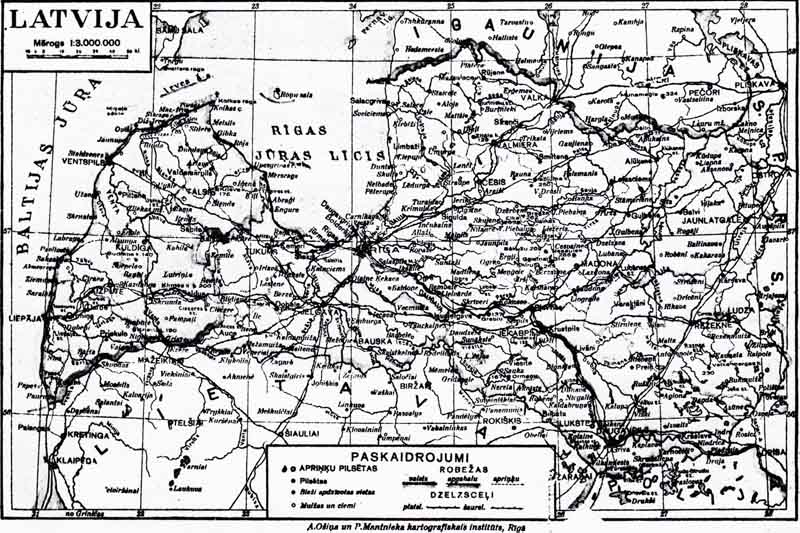
This map became one of Adele’s honeymoon souvenirs.
Zvil was the place where Adele was born and where her mother and grandfather are buried. When she and Max arrived there they found the Jewish section in Zvil had been burned down and no rebuilding had occurred. But they did find some relatives.
“My father had two sisters. One had just died and been buried when I went there on my honeymoon. Her husband already had another woman in her place in the house. When I saw this, Max and I left immediately. My uncle (by marriage) ran after us and met us on the platform at the train station. He pleaded with us to return. He had a Torah that had belonged to the Korff family for about 500 years. He said it had no meaning to him and he gave it to us. [The Torah was later used in the Bat Mitzvah ceremony of my granddaughter, Leslie Gass, and the B’nai Mitzvot of other Korff descendants.] My uncle also gave me some kiddish cups.
“Max and I brought along the $10,000 we had been given as wedding presents. I never counted the money and I never wrote any thank you notes. We gave all the money away and came home penniless, without even the clothes we had taken with us, just wearing the clothes on our back.
“My mother’s father had been a grand rabbi. When I went to my mother’s hometown of Korets, Poland, the whole town turned out. My maternal uncle, Rabbi Yankele Goldman, lined up the people, and as they came around he told me how much money to give each one. This one is a big businessman, don’t shame him. This one needs a little more, he has small children. These people had money at one time, don’t shame them.
“We gave away all our money, cabled home for more, and gave that away, too. I had expected to give away the cash but I had not expected to give away my trunk full of clothing. But Yankele would introduce me to a young girl and say, She’s getting married, she needs a new dress…
“It did not bother me to give the money away. Money never meant anything to me even as a kid. Money meant the good you could do with it. On the way to Europe, Max and I had traveled first class. We dressed for dinner in tuxedos and gowns. But we came home with very little clothing. We traveled first class on the return, wearing the same clothes over and over.
“We didn’t have enough money left for tips at the end of our trip so we were met by family in New York. They came on board our ship, the Queen Elizabeth, to give us money for the tips. Our honeymoon was cut short after only 10 weeks abroad because the political situation in Europe had worsened.
Grand Rabbi Jakob I. Korff sent both of these telegrams relating to the return of the newlyweds. The reason for the urgency of the second, sent to Adele’s older brother Rabbi Baruch Korff, is not known.
“After our honeymoon, we tried to get our relatives out of Europe but we were unsuccessful and we lost my mother’s family—the Goldmans. They had originally came from Zvil and then moved to Korets. Uncle Yaakov (Yankele) Goldman, who was a widower, perished along with his four children in Korets. In 1938, the children—three boys and a girl—had ranged in age from 11 to 15. They probably died in 1941 or 1942.”
Read a letter that Rabbi Yaakov Goldman wrote to Adele and Max, as well as a letter from an unidentified aunt of Adele’s in Poland
Rabbi Goldman’s letter is so poignant because it is clear his situation is desperate and he needs the help of his American relatives, yet he does not want to burden them.
Adele pasted the newspaper clippings from her wedding and the honeymoon photographs onto lined notepaper, which she assembled into a scrapbook. Most of the photos were not labeled on their backsides. Of the few that were labeled, the inscriptions of many were obscured because of the paste. As a result, only one group of photos can be identified with any certainty, those of people who are related to Max Gass on the side of his maternal grandmother, Chane Goos neé Schwarz who lived in Turiysk. These photographs appear to have been taken by a professional photographer.
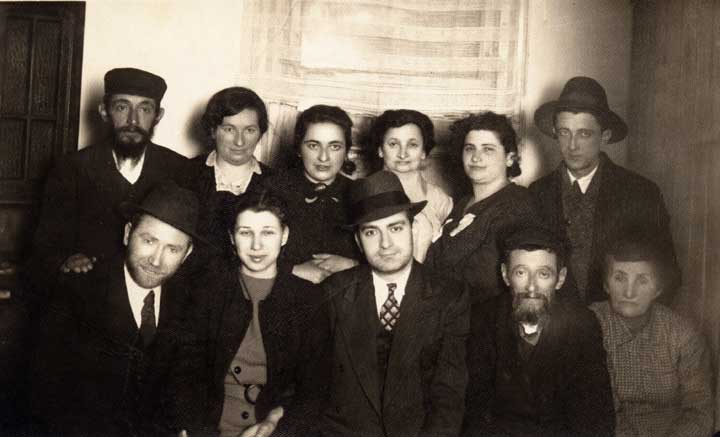
There are two identical photos from 8 March 1937 with different Yiddish inscriptions on the back. One says “To the eternal memory for our dear cousins Matusyahu Aaron [Max] with his wife Odileh [Adele], from your cousin with his family, Yisroel Zvi Schwarz.”
The other says “In remembrance of our dear cousin Shlomo [Sam Gass] and his family from the family of Chaim Meyer and his children.
There are two identical photos from 8 March 1937 with different Yiddish inscriptions on the back. One says“To the eternal memory for our dear cousins Matusyahu Aaron [Max] with his wife Odileh [Adele], from your cousin with his family, Yisroel Zvi Schwarz.” The other says “In remembrance of our dear cousin Shlomo [Sam Gass] and his family from the family of Chaim Meyer and his children.
In the front row of the photo are Adele and Max. The best guess of this editor [CGV] is that Chaim Meyer and his wife are seated to the right of Max (because the inscription reads “from the family of Chaim Meyer and his children” and the other people could be his children.) To the left of Adele would be Yisrael Zvi Schwartz as he appears prominently in other photos too. And he signs his inscription “from your cousin…with his family” [not “with his children”].
What is not clear is whether Chaim Meyer’s last name is Meyer or if Meyer is his middle name. If the surname is Meyer, than he is the son of a married sister of Chana Goos’s.

This text is in Hebrew: Lemazkeret netsakh hineni, Noten et tmunatenu leadon, Matetyahu aharon uleishto
Zev Natanblit
Translation:
For eternal remembrance I present this picture to Mr. Matetyahu-Aharon and his wife,
Zev Natanblit
Europe 1937
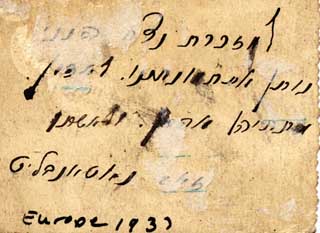
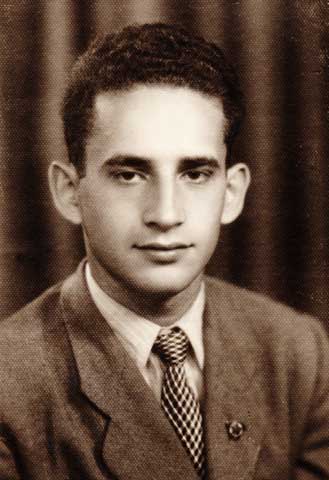
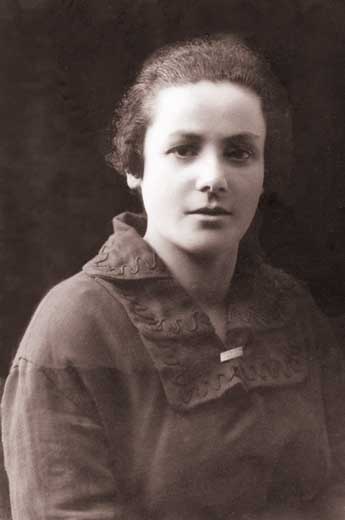
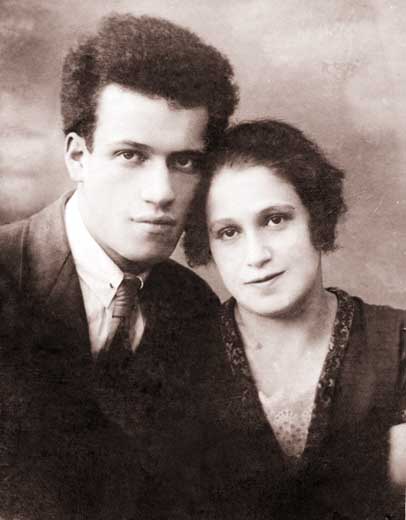
Note the tightly curled, kinky hair and similar hairline that the man in the left of the first photograph shares with the two in the other photographs. These three people could easily be siblings. The inscription for the last photograph is written in Russian. Translation: For good remembrance to the dear nephew Grisha. [Could this photo be intended for Max’s deceased uncle, Gershon Gass? Who else could Grisha be?]
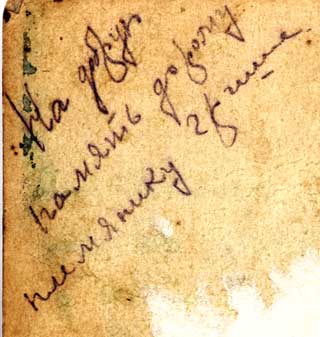
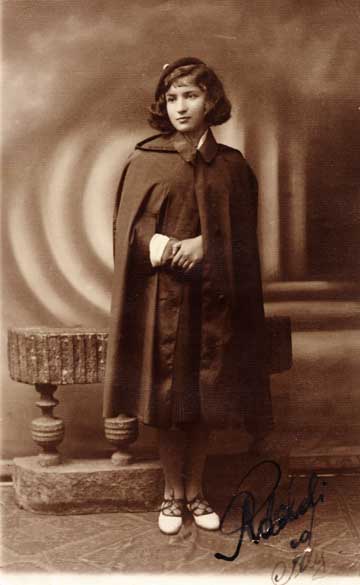
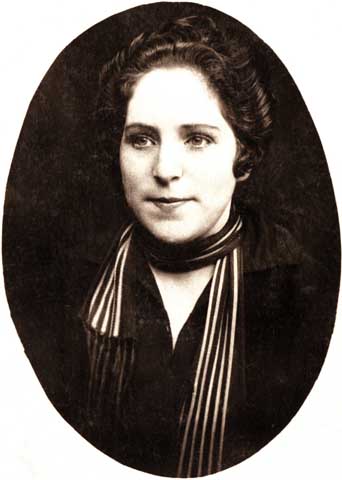
Who are these two young, sophisticated women? Did they survive the Holocaust? A stamp on the back of the first photograph indicates that the photographer was located in Rovno. The photo is dated 17 February 1937.
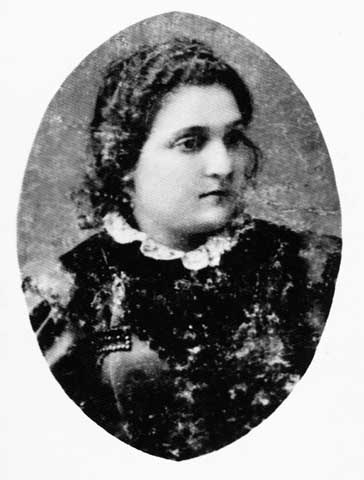
Could this woman be the same woman as found at the right end of the second row in the following photograph? Could it perhaps be a picture of a sister of Chana Goos’s (note her clothing is much older style than that of the women in the group photographs.)
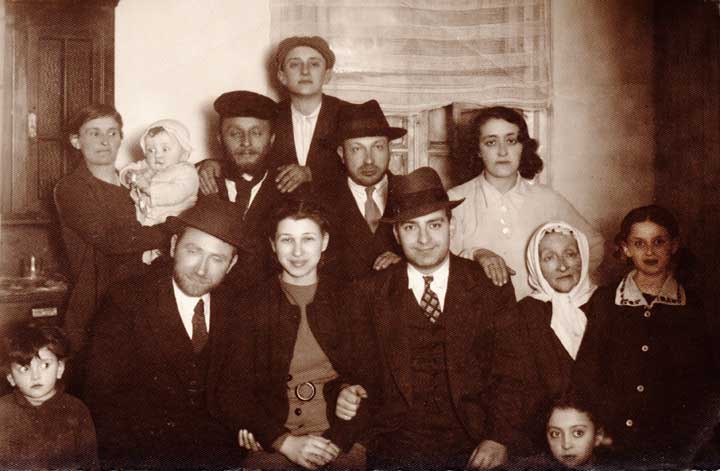
The man who most likely is Yisroel Zvi Schwarz appears with Adele and Max in another group setting with two other sets of people. In the first, young children are included. The best guess is that these are Yisroel’s siblings or first cousins with their spouses and children. Perhaps the old woman in the photograph is Ysroel’s mother. The other photograph with just young adults, could be Yisroel’s siblings or cousins.
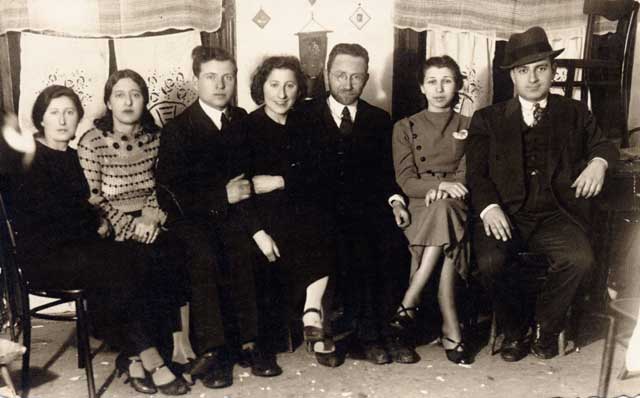
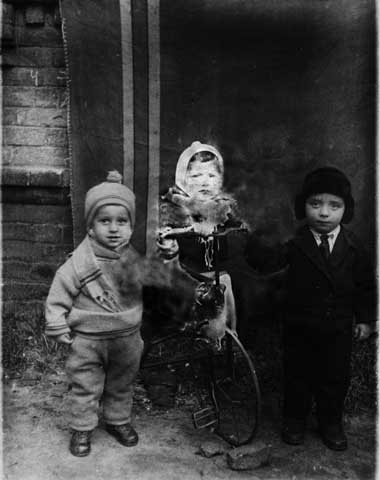
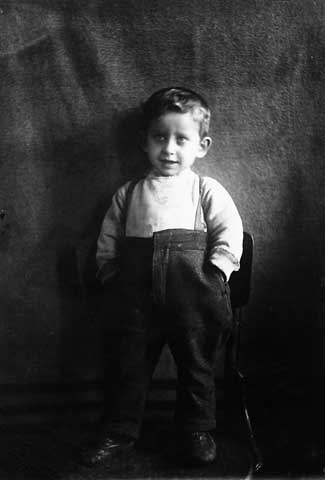
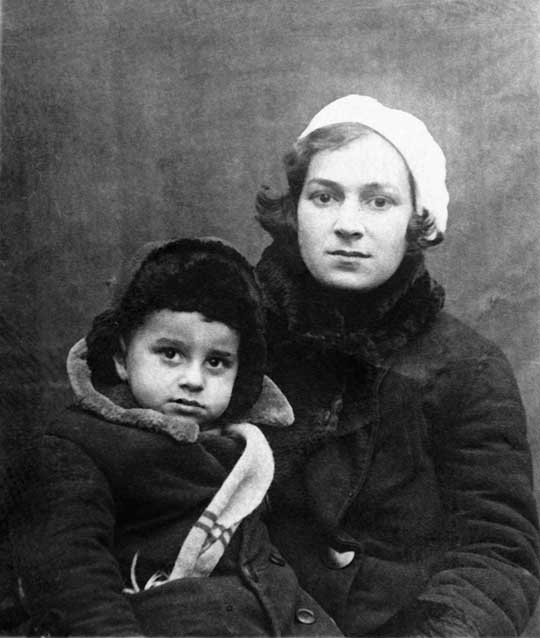
The first two photographs were printed on identical photo paper that differed from that used in the other photographs in Adele’s collection. The boy on the right in the group photo appears to be the same as the boy featured in the third photograph with a woman who is probably his mother. Could this woman be the same as the one at the left end of the row of young people in the picture immediately preceding this set?
Adele apparently took the next set of photographs as Max is featured in a few of them. It is not clear in which town they were taken or who the people are. However, the man on the right in the first photo in this sequence has a resemblance to the man in the front row, second from right of the first photograph on this page.
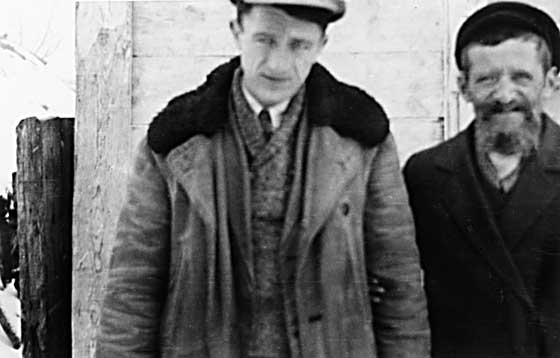
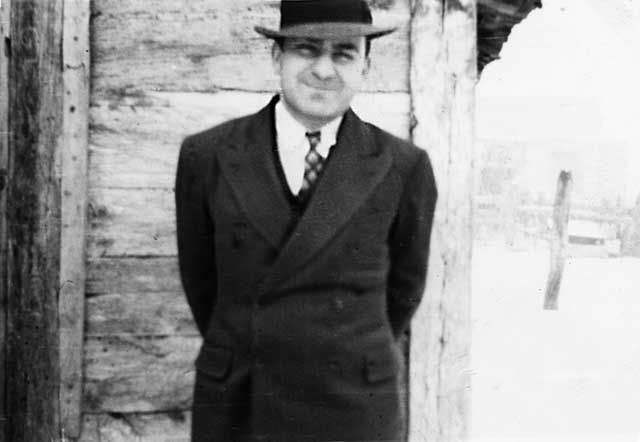
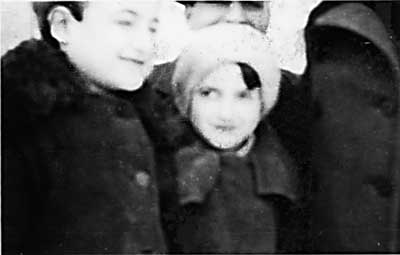
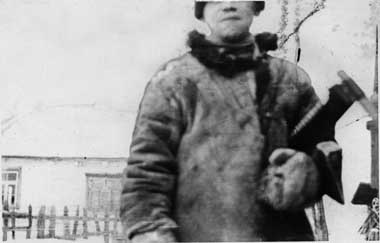

Unidentified relatives of Adele’s and or Max’s. It is unlikely that these people survived the Holocaust.
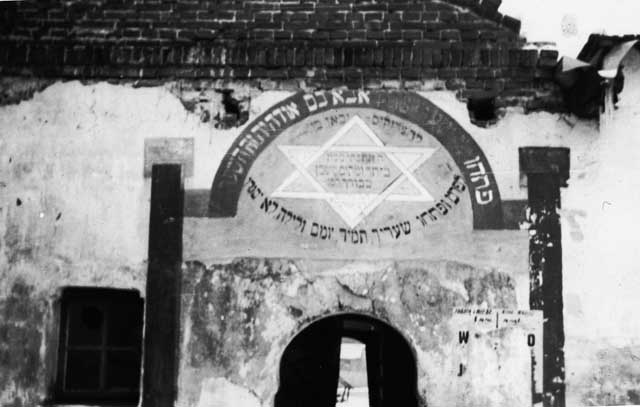
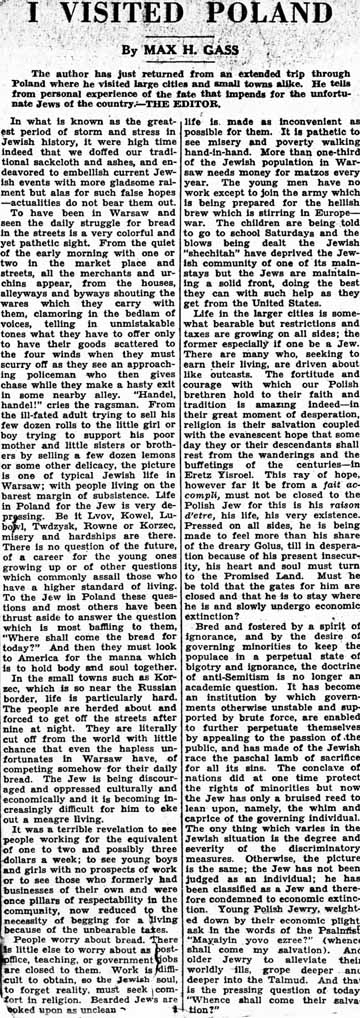
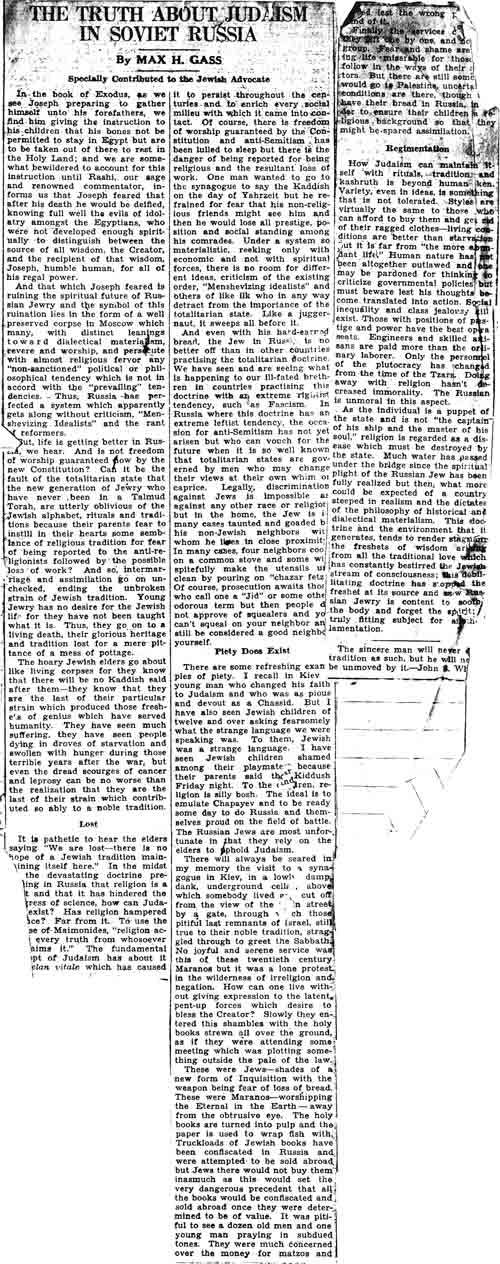
Max Gass was so moved by the plight of the Jewish people in Russia and Poland that when he returned home from his honeymoon he wrote two newspaper articles about his experiences.
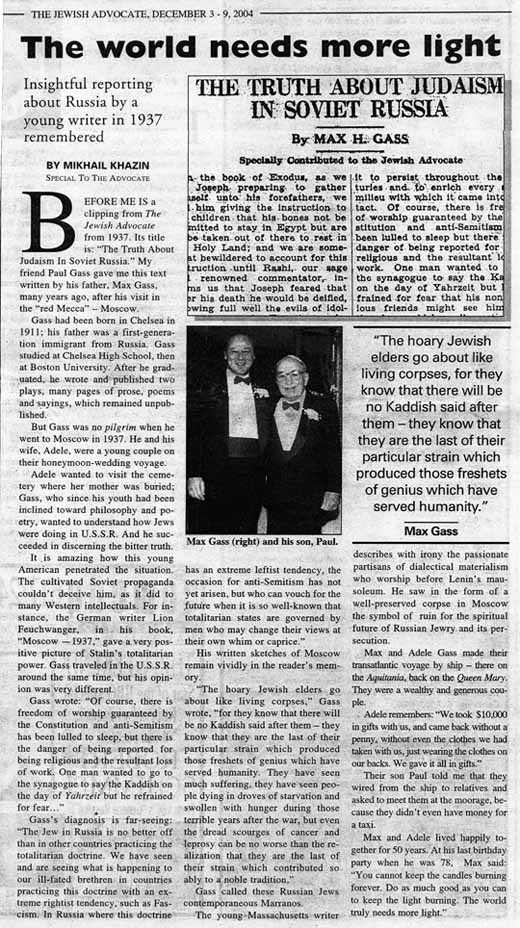
Translator and writer, Mikhail Khazin, found Max’s article on Judaism in the Soviet Russia so compelling that 67 years after it was originally published, he wrote his own article about Max and his observations. Khazin’s article was published in The Jewish Advocate in December 2004 and is reprinted here with permission from Khazin and The Jewish Advocate.
